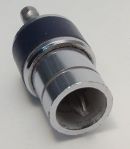 I was at Strata + Hadoop World in New York last month, but did not notice this presentation in the agenda (FWIW, I don’t think O’Reilly’s conference agendas are easy to read nor attendee-friendly). But then, I somehow stumbled onto this excellent piece by Virginia Heffernan on Backchannel: Big Moose Is Watching You. It tells the big data customer segmentation story of Maine-based outerwear retailer L. L. Bean. Obviously Virginia is better at navigating the conference agendas than I am, and was able to relate this story told at Strata.
I was at Strata + Hadoop World in New York last month, but did not notice this presentation in the agenda (FWIW, I don’t think O’Reilly’s conference agendas are easy to read nor attendee-friendly). But then, I somehow stumbled onto this excellent piece by Virginia Heffernan on Backchannel: Big Moose Is Watching You. It tells the big data customer segmentation story of Maine-based outerwear retailer L. L. Bean. Obviously Virginia is better at navigating the conference agendas than I am, and was able to relate this story told at Strata.
I won’t repeat what’s in the article, which is definitely worth a read. Just maybe summarize the conclusion: your marketing is much more efficient if you are targeting the customer with the exact products they like and are interested in. It’s “know your customer”, but elevated to the power of 10. This reminds me of another story I have heard of fine-grain customer segmentation.
This is the story of an (unnamed) home improvement retailer. This retailer had noticed that they were getting many repeat customer visits to their stores. So far so good, right? Well, not exactly. A lot of these repeat visits happened within a few hours timeframe. Of course, there was the possibility that customers liked the stores so much that they enjoyed spending their Saturday there. Or, most likely, that they had forgotten to pick an item or an accessory during their initial visit, and had to drive back to the store, a little annoyed at themselves…
Take me as an example. I work hard during the week, writing blog posts and such, and on weekends I’ll try to tackle the next thing on a to-do list that my lovely wife dutifully maintains (“when you have time, maybe we could try to finish this walk-in closet…” – that sort of things). But when I go to my local DIY store to buy the drywall panels and screws, it’s unlikely I’ll remember to buy the screw setter for my drill. And I would LOVE for the checkout clerk to ask (casually): “Yves, I see you bought a cordless drill last year, but I don’t see a screw setter in your purchase history, do you have one?” Because then I could run back to the aisle she would have pointed to me, grab the said accessory, and not waste an hour driving back to the store 2 hours later.
Now, if I was a home improvement pro, buying 100 panels a week and screws by the bucket, I would probably feel a little insulted when asked if I have the proper tools. But I would not mind a free cup of coffee while they load the panels on my truck…
That requires that the retailer not only knows who I am, but knows who I actually am. Not just my email address to send me a bunch of spam, but that I am a (handsome) 40-something executive, living in an apartment, married and with three (lovely) kids, who tries to fix things at home himself but usually ends up breaking something else (but rarely hurts himself doing so, unlike some Redmonk analyst I know, who happens to live near to where L. L. Bean is based).
Then you have the other approach. One day, I was researching TVs online. I may have stumbled onto Amazon’s site while doing so. Then I went to buy a TV in a store. For the next 6 months, I ended up getting 3 or 5 emails per week from Amazon with all kinds of information and offers on TVs. It finally stopped – phew. Amazon, know this: unless it’s a 4K 100-inch screen, nobody does advanced research or even waits for 6 months before buying a new TV. I needed one, I bought one. I could have taken a few spams for a week or two. A discount coupon, sent an hour after I had closed my browser and you realized I was not buying today, could actually have gotten you my business. But 6 months of spam… whoa.
Of course, I’ll keep buying books from Amazon – especially for my Kindle. But I am not sure I’ll go there next time I’ll want to research electronics.
Because I don’t think they know me as they should know me.
Digitally yours,
Yves
@ydemontcheuil
Pingback: From store to internet to store | Digitalization of Everything